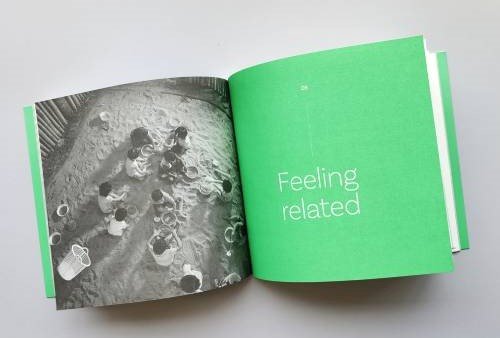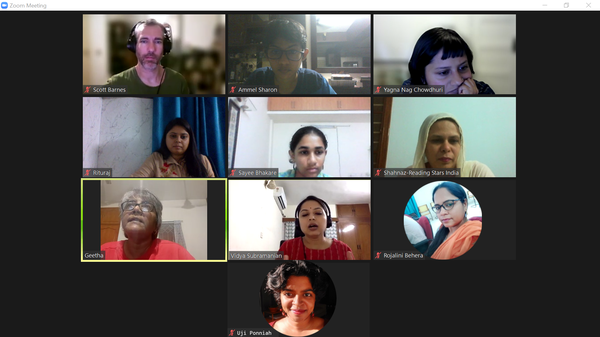
"And what is the use of a book," thought Alice, "without pictures or conversations?"
Understory has a broad interest in pedagogy. When we learnt of Ashwin Prabhu’s book, Classroom with a View: Notes from the Krishnamurti Schools (Tara Books, 2022), we were intrigued and read it with interest. We liked that someone had written about a network of schools that has developed and sustained a distinctive, autonomous pedagogy based on Jiddu Krishnamurti's teachings. Further, we appreciated that this work, published by a small, Indian independent publisher, isn't meant only for specialists but for a public interested in matters of education. The layout, typography and colour scheme make it a readable book, well-designed and distinctive.
Classroom with a View is written in seven chapters which go beyond literacy parameters. Often, the book explores aspects of education which are considered peripheral: developing a relational self, a role for silence, an extraordinary emphasis on art, exploring the scope for learning outside the classroom. Each chapter provides several exercises developed through collective deliberation and reflexivity. The latter parts of the book deepen questions of social engagement, explaining the introduction of dry toilets at the school or working with rural children. The focus isn't only on children, for Jiddu Krishnamurti was conscious of the need to 'educate the educator'.
You can read more about the book including an excerpt here and another here.
We did not wish to review the book, however, and decided, instead, to heed its invitation. For instance, the author recalls a Culture Class exercise where students shared spontaneous reactions to their peers' feelings of conflict and doubt: [The teacher] requested that those who responded did not simply agree or endorse what was said, nor only debate or judge. Instead, they were to respond, from their own experiences.
To respond from one’s own experience seemed a fruitful way to expand the scope of the book, while retaining its guiding spirit. We were lucky to find several people with interests in education to engage with us. In keeping with the ethos of Understory, we hoped to elicit from our participants their observations about pedagogy from their contexts. We asked them to use CV to speak of classroom dilemmas they have encountered, and to think about what differences in institutional and social locations mean for pedagogy. Hence, the book served mainly as a springboard (but what wonderful ideas it contains!).
Our aim was to:
- Have our discussants read the book, but not burden them with expectations of originality or finished opinions;
- Have them speak from a place of familiarity, strength and purpose;
- Foster a sense of interconnectedness between our discussants.
Yagna facilitated the discussion and was interested in how this book could speak to scenarios beyond the classroom. She was particularly taken by the clay-modelling class where a student played repetitively with clay, and the process of shaping, building, breaking it down helped him become a professional writer (pp.158-159). So many small, everyday actions remain unsaid in education initiatives, but have a complex bearing on student lives.
Rojalin attributed the high rate of school drop-outs in India to the inability of students to express themselves to their teachers and classmates, because of a pervasive sense of fear. She felt that educational justice must begin by becoming familiar with the child's background and establishing meaningful connection with them.
Vidya addressed the hierarchy between the teacher and student. As a young woman teacher who wishes to be taken seriously at an elite university, she has to deal with conflict and sometimes an absence of civility; she is unwilling to give away her authority. She noted that the book felt like a dialogue with another pedagogue and was to be taken in that spirit, where the 'extra-curricular' becomes the focus.
Shahnaz drew attention to the ASER Report which found that only 19% of Karnataka students in Class 3 are able to read. In her experience of building classroom libraries in Bangalore and Hyderabad, she found that allowing children to linger on illustrations aided them in slowly picking up literacy, rather than rushing students to pick up letters.
Ritu found that when she introduced group tasks, students began to open up. To deal with deadlines and assignments, she assigned semester-long reflective diaries and encouraged journaling. This helped students express themselves better. Small group tutorials helped students open up about difficult subjects like gender and violence, and share more openly than in large classrooms.
Sayee said that though her school incorporates newspaper articles and innovative methods, the exercises are always garnered towards achievement, and not freedom. She enjoyed the book, which had made her think about Totto Chan: Little Girl at the Window.
Scott found that even where the emphasis is on performance and tests, students are willing to be flexible and pursue creative methods if they find the classes interesting.
Ujithra felt that the poetry section where simple expressions with different ending lines can provoke discipline from within and create joy for a student, is a useful way of slowing down time.
V Geetha responded to the discussion saying,
- We need not treat schools as the final work on education, and instead focus on relationships, peer communication, multi-sensory education
- Though she began with a political economy critique of the social class of KFI schools, she came to appreciate the form of learning that other schools can take up, and recreate the classroom.
- It is evident that state schools do not prepare students for competitive success - such success is determined by pre-existing social capital. In this scenario, it is helpful to create other kinds of possibilities; focus on other forms of learning that make schools a social place where people live and learn together.
- When she taught History and Civics to the 10th standard students, they produced charts together on how to learn for the exam at the beginning. The rest of the time was spent on expanding the scope of reading. She introduced Alok Bhalla's stories on partition where they talked about what happened to children during partition.
- In Civics classes, they focussed on fundamental rights in their everyday lives, and students shared their observations of inequality, which was an occasion for students to express their discomfort within the public as well as private spaces.
Many books came up in the course of our discussion. You may like to look them up.
Ahalya Chari, Thinking Together (1997)
Tetsuko Kuroyanagi, Totto Chan: The Little Girl at the Window (1981)
AS Neill, Summerhill: A Radical Approach to Child Rearing (1960)
David Elkind, The Hurried Child (1981)
Gijubhai Badheka, Divaswapna: An Educator's Reverie (1939) (Hindi)
